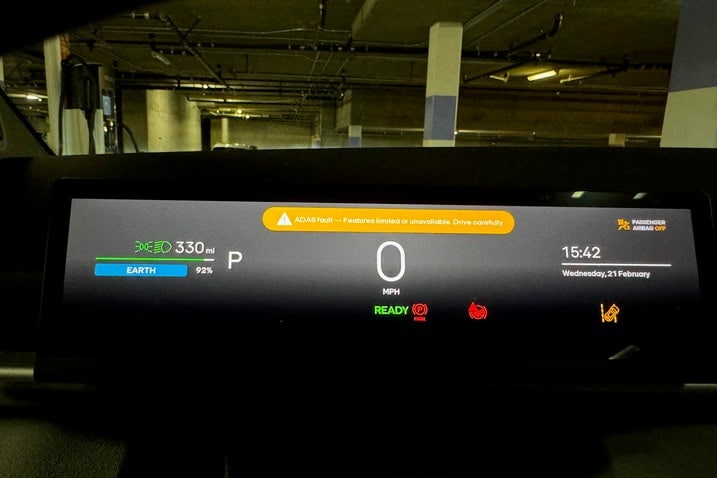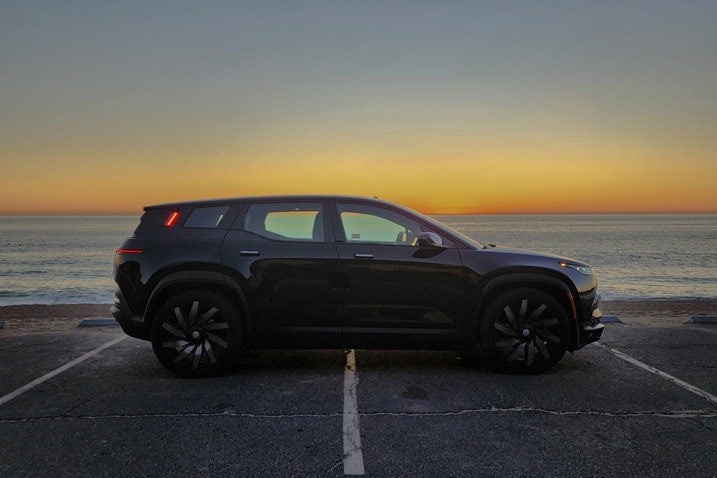- To clear out old inventory, Fisker is dramatically reducing the price of the 2023 Ocean electric SUV.
- Shoppers will surely be drawn in by the promise of a brand-new $25,000 long-range EV.
- As owners of a Fisker Ocean, Edmunds attests that the current software is less buggy than previous iterations.
- However, with the car currently in an incomplete state and Fisker's future uncertain, Edmunds recommends that you do not buy the Ocean, with caveats.
Do Not Buy a New Fisker Ocean
Fisker's uncertain future makes buying an Ocean too much of a gamble
On Wednesday morning, Fisker Inc. announced that a substantial price reduction to 2023 models of its sole vehicle, the Ocean electric SUV, is set to take effect today, with the most drastic cut amounting to $24,000. While the aggressive pricing is undeniably attractive, our ownership experience with a 2023 Fisker Ocean Extreme that we purchased reveals a vehicle that still isn't ready for prime time, and given the dismal outlook on the automaker's solvency, we're uncertain that all of our vehicle's issues will ever be fixed. With the current model still missing a lot of promised features, and the company's future in doubt, we can only recommend one thing: Do not buy a new Fisker Ocean.
Price cut details
The range-topping Extreme sees the biggest drop, with its starting price of $61,499 plummeting to $37,499, representing a discount of $24,000 (all prices do not include destination charges). The midtier Ultra is reduced from $52,999 to $34,999 (-$18,000) and the entry-level Sport now retails for $24,999, down from $38,999 (-$14,000). This appears to be the pricing for all existing 2023 inventory in a particular trim level regardless of individual vehicle options, as Fisker states, "Certain Ocean vehicles come equipped with as much as $7,000 worth of additional options — such as colors, 22-inch wheels, interiors and other options — included in the discounted price."
The current Ocean OS 2.0 software build
We published an article in February detailing our myriad frustrations with our Ocean in its then-current form (software build 1.11). Among our many issues with the car, we noted the unreliability of the key fob, random failures of driving aids like the blind-spot monitor, the audio system volume not responding to user input, the audio system failing completely, Bluetooth connectivity dropping, and the car's tendency to roll back on a hill — you know, like when you were learning to drive a manual transmission.
A few days after we published that story, we downloaded and installed a massive update to the car's governing software. Dubbed Ocean OS 2.0, the three-part update promised to bring numerous quality-of-life improvements — including fixing some of our most glaring complaints — and introduce new features, such as trailer sway control and a new menu that shows the charging performance of the roof-mounted solar panels.
Installing the first part of the update rendered the car inoperable for 30 minutes, but the next two automatically downloaded and installed without us requesting or having to accept the updates. Since the process happened so seamlessly, it's hard to know exactly when they occurred but they were completed sometime in the week or so following the initial update. This is notable because Fisker initially said the updates would render the car undrivable for up to two hours each, but it turned out to be much easier than that. Other vehicles in general don't download or install updates while driving or charging, giving the Ocean a leg up on that front.
Impressions from our team post-update are mixed, as some of our ownership issues have been addressed but problems remain. Rex Tokeshi-Torres, associate manager of vehicle operations, says, "It was pretty common for the dashboard to display a list of errors when I started the car, but post-update, the instrument panel is refreshingly warning light-free. The touchscreen interface responds noticeably more quickly to user inputs. Unfortunately, the useful consumption display (the electric equivalent of a gas car's mpg estimate) has disappeared, and we haven't been able to find it — if it exists at all — in any submenu screen yet."
Senior reviews editor Brian Wong also spent time with the Ocean post-update and had this to say: "The biggest quality-of-life improvement has been the key fob. It now works on the first click and doesn't require you to hold the fob up to the door handle to unlock the Ocean in a timely fashion. There's also a true brake hold feature now, too. When you stop, the speedometer disappears and the instrument cluster instead displays a large 'H' to indicate the vehicle is being held. Then when you press the throttle, you glide away. However, there's a catch — Fisker didn't want people leaving the vehicle with automatic vehicle hold activated and the Ocean still in drive. So the system uses a weight sensor to detect if the seat is still occupied, and if it thinks you've exited the vehicle, the Ocean goes into park. The problem is that this sensor is way too sensitive, as I found while I shifted my weight in the seat at a stoplight. Imagine my surprise when I pressed the accelerator and nothing happened. The car had put itself into park with no warning! Even something as simple as leaning across to grab something off the passenger seat can trigger this. Yes, Fisker has made some improvements with this update but overall, the Ocean's systems still need more refinement."
All 2023 vehicles sold at the drastically low starting price will be loaded with Ocean OS 2.0 at the time of delivery.
Still missing promised features
When you look at a car's window sticker and see the list of features included on your vehicle, you expect them to be there, right? That's not the case with the Ocean, which was launched in an unfinished state with an astounding number of missing features. Items listed on the Monroney window sticker but still not active include adaptive cruise control and an automated parking system. Other features not listed on the window sticker and also not active include automated lane centering and the Powerbank vehicle-to-load charging system, which allows the Fisker to power high-voltage devices using an adapter that plugs into the charging port.
In a January 2024 interview with Automotive News Europe, CEO Henrik Fisker affirmed adaptive cruise control and other unspecified "missing advanced driver-assistance systems" would be released on April 1, 2024. That target will be missed, with a Fisker representative saying that these features are on the roadmap for over-the-air updates for 2024 but declining to provide a more specific timetable.
When you invest in the car, you also invest in the company
So the car itself remains buggy and incomplete, but for an established automaker, that's not necessarily a death sentence. The issues we experienced with a Chevrolet Blazer EV we purchased for our long-term test fleet are well-documented and likely contributed to a stop-sale order for the electric SUV that lasted months. But even though Chevrolet, and GM overall, have had a difficult time with new EVs based on the Ultium battery platform, any reasonable person would expect that one of the world's biggest automakers would figure out a solution eventually.
But a startup like Fisker doesn't have the benefit of time. The company is suffering from a series of blows, from a proposed EV-building partnership with Nissan falling through to its stock being delisted from the New York Stock Exchange because the share price fell below required levels. The possibility that the automaker won't exist in a year (a section of the company's 2023 financial results is titled "Substantial Doubt About Fisker’s Ability to Continue as a Going Concern") should be the single most important consideration for interested shoppers.
Instead of asking, "When will Fisker fix my car?" shoppers will have to come to terms with more existential questions. "What happens to my car if Fisker ceases operations? Will the updates that unlock the features I paid for be released on time? Will the software bugs I'm experiencing ever be fixed? Who will service the car if Fisker isn't around?"
The Ocean targets the wrong audience
Tesla laid the groundwork for the business strategy that Lucid and Rivian would eventually adopt when launching their own first cars: Target high net-worth individuals first. Not only are margins generally higher (making it easier to keep the company afloat), but this kind of buyer has a higher tolerance for vehicle downtime.
Drive through tony LA suburbs like Calabasas and Beverly Hills and you'll find a glut of insert-off-road-luxury-SUV-manufacturer-here products wafting along perfectly paved roads. Translation: If these cars unexpectedly fail and need to be in the shop for weeks at a time, it's not really a big deal for this kind of owner. They'll simply pull another one from their garage for the biweekly Whole Foods run. This kind of buyer is ideal for a startup with growing pains; if the motors seize, or the touchscreen blacks out, or — in the case of our old long-term 2013 Tesla Model S — the entire drive unit needs to be replaced three times, there's an easy solution. And because buyers know they're early adopters, they're generally more willing to put up with such hiccups.
But the Ocean targets the heart of the EV market. Data collected by Edmunds shows that the average transaction price for an electric vehicle was $61,702 in 2023, and a recent Edmunds survey shows that nearly 50% of prospective EV shoppers want a car that costs less than $40,000. At the Ocean's pre-drop price range of $38,999 to $61,999, it lined up with exactly what people say they want and in a body style they desire (42% surveyed say they prefer an SUV/crossover and 43% want a car/wagon; the Ocean arguably plays in all these categories).
But this audience also prizes reliability. These are everyday working people who don't have the time to bring their EV to a service center for the umpteenth time this month, or the means to hand the keys to an assistant who specializes in making problems go away. A glitch-laden vehicle is a major stressor for individuals without this kind of support.
Dismal resale value
We purchased our Ocean Extreme in January, with a sticker price of $69,012. On top of an MSRP of $61,499 and destination charge of $2,438, we added 22-inch wheels ($1,600), white Alcantara interior ($2,500), and the Silver Lining paint scheme ($975). We've driven it for just over two months and 4,000 miles, and in one day, its resale value on paper dropped at least 43%. This figure doesn't take the destination charge into account — which may have changed since purchase — and is based solely on the price we paid and the new MSRP. It doesn't take into account any depreciation.
We took our Ocean to our local CarMax store for an appraisal on March 29, to see how the value has been affected by the company's woes. (Full disclosure: Edmunds is a division of CarMax.) We were presented with an offer of $21,000. That's a depreciation of 69.6%.
Over the past few years, we've seen manufacturers dramatically reduce EV prices with little warning as they adopt to turbulent demand for electric vehicles. Such severe cuts leave early adopters out in the cold with vehicles that are suddenly worth thousands of dollars less, and owners are typically (and understandably) unhappy with this prospect. This is likely why Chevy reimbursed existing Blazer EV owners for the price difference when it dropped the MSRP of new models. Though it likely cost GM somewhere in the neighborhood of $2.8 million to $3.2 million, it also likely earned the automaker a substantial amount of goodwill.
Fisker has confirmed there is not a similar plan in place for reparations for current owners, and in doing so, the company has turned its back on the buyers that supported them from Day One. If Fisker is able to survive, it will do so with an existing customer base that is now conditioned to be wary of potential pricing alterations.
It's also worth mentioning third-party dealers who took Fisker Oceans as a trade-in. With these price cuts, each one is now potentially sitting on a five-figure loss, which could lead to some dealers refusing to make an offer when a customer wants to trade in their Ocean.
Do not buy a Fisker Ocean
While Fisker's future is murky at best in the current, there are paths forward. The company is undoubtedly selling the 2023 Ocean inventory at a loss, and a return to pre-drop pricing for 2024 models is unlikely to drive customer demand. Funds for continuing operation will assuredly have to come from outside funding, and aside from a promise of $150 million from an existing investor (which might be at risk as a result of one of the contingencies of the investment not being met), Fisker has not publicly announced other major cash injections. It's certainly possible that an outside entity could look at Fisker's business model and decide to float the beleaguered automaker.
However, buyers cannot be expected to pin their next car buying purchase on the hopes and dreams of an automaker's existence.
Edmunds recommends that shoppers do not buy a Fisker Ocean until the company can deliver the updates that bring promised features to the car, and the company is on more solid footing.
Albert Hernandez, Rex Tokeshi-Torres and Brian Wong contributed to this story.
Edmunds says
We hope the struggling automaker can find a way forward out of this mess and survive not only for the sake of existing and interested customers, but also for the more than 1,000 people it employs globally. But we cannot recommend that shoppers risk buying a new Fisker Ocean as long as the company's continued existence is in such doubt.



 by
by